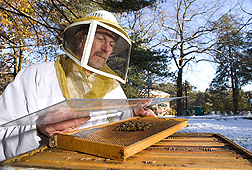This page has been archived and is being provided for reference purposes only. The page is no longer being updated, and therefore, links on the page may be invalid.
Read the magazine story to find out more. |
|
|
Coordinated Research Aims To Improve Honey Bee Health
By Alfredo FloresFebruary 1, 2008
In response to a fast-spreading syndrome called colony collapse disorder (CCD) that's striking honey bees nationwide, scientists at Agricultural Research Service (ARS) bee laboratories across the country are pooling their expertise. They want to learn what’s causing the disappearance of the honey bees that add about $15 billion a year to the value of U.S. crops by pollinating fruit, vegetable, tree nut and berry crops. Some beekeepers have already lost one-half to two-thirds of their colonies to CCD.
Jeff Pettis, research leader at the ARS Bee Research Laboratory in Beltsville, Md., is a coordinator of the newly established five-year Areawide Program to Improve Honey Bee Health, Survivorship and Pollination Availability. Entomologist John Adamczyk at the ARS Beneficial Insects Research Unit in Weslaco, Texas, helps Pettis coordinate the program, along with Gloria DeGrandi-Hoffman at Tucson, Ariz., and Tom Rinderer at Baton Rouge, La. This is the first such initiative to bring various components of all of the federal bee laboratories together to solve a single problem.
Researchers at Beltsville are attempting to improve the longevity of honey bee queens, find effective controls for Nosema protozoa and varroamites, and reduce migratory colony stress. In Weslaco, work also focuses on controlling varroa mites and Nosema, reducing migratory stress and developing disease-control measures.
At the ARS Honey Bee Breeding, Genetics and Physiology Research Laboratory in Baton Rouge, Rinderer and colleagues are looking into bee stock evaluation and improvement, with a view toward using genetic selection and colony size to improve early spring buildup.
In Tucson, Degrandi-Hoffman is leading scientists at the ARS Carl Hayden Bee Research Center in studying carbohydrate and protein supplements, Africanized bee stock improvements and varroa mite controls.
The new bee-focused areawide program will also incorporate university partners, apiculturists and many others. By the end of this coordinated five-year effort, researchers hope to have specific recommendations ready for beekeepers to use to manage their bees more efficiently and improve colony survival, especially during long-range transport.
Read more about this research in the February 2008 issue of Agricultural Research magazine.
ARS is the U.S. Department of Agriculture’s chief scientific research agency.

